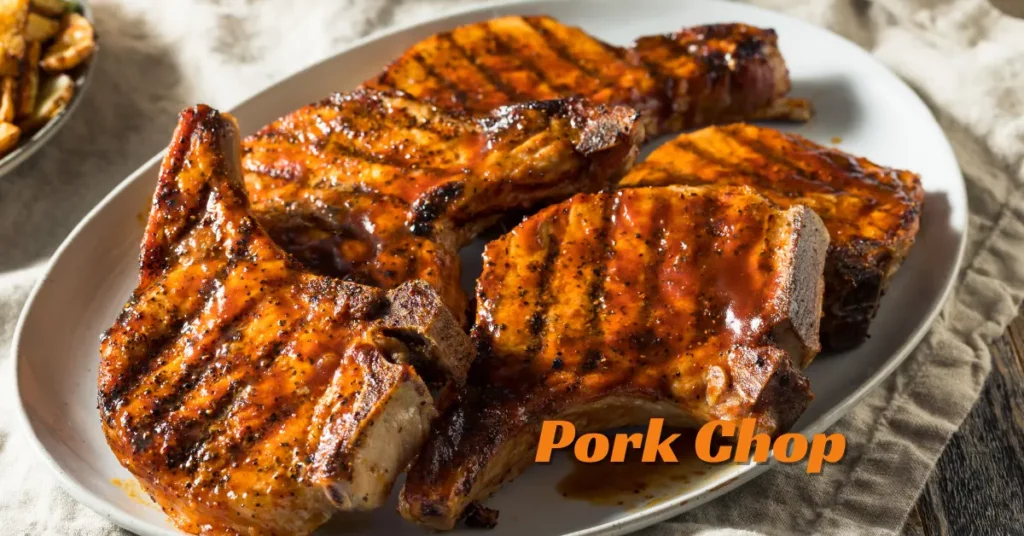This post may contain affiliate links. If you use these links to buy something we may earn a small commission. Thanks.
Pork chops are one of the most popular cuts of pork, known for their tenderness, rich flavor, and versatility in cooking. As a great source of high-quality protein, pork chops can be an excellent addition to a balanced diet. But how much protein do they really contain? Whether you’re a fitness enthusiast, an athlete, or just someone looking to maintain a healthy diet, understanding the protein content in pork chops can help you make informed dietary choices. This article explores the protein content in different types of pork chops, factors that influence it, and how they compare to other protein sources.
Protein Content in a Pork Chop
The protein content of a pork chop depends on its size, cut, and whether it is cooked or raw. Below is a breakdown of the typical protein content per serving:
- Boneless Pork Chop (Raw, 3 oz) – Approximately 22 grams of protein
- Bone-in Pork Chop (Raw, 3 oz) – Around 19-21 grams of protein
- Boneless Pork Chop (Cooked, 3 oz) – Around 26 grams of protein
- Bone-in Pork Chop (Cooked, 3 oz) – About 23-25 grams of protein
A standard 6 oz boneless pork chop contains about 44-48 grams of protein, making it an excellent protein-rich option for those looking to meet their daily intake needs.
Factors Affecting Protein Content
Several factors influence the protein content in a pork chop, including:
1. Cut of the Pork Chop
There are different types of pork chops, including:
- Loin Chop – One of the leanest cuts, high in protein.
- Rib Chop – Slightly higher in fat but still contains a good amount of protein.
- Shoulder Chop – Higher in fat and connective tissue, slightly lower protein per ounce.
- Sirloin Chop – A mix of lean meat and fat, providing a moderate amount of protein.
2. Cooking Methods
Cooking a pork chop affects its protein content due to moisture loss. As the pork cooks, water evaporates, leading to a denser protein concentration per ounce. Here’s how different cooking methods affect protein levels:
- Grilled Pork Chop – Retains most of its protein content while reducing fat.
- Pan-Fried Pork Chop – Maintains protein but may add extra fat depending on the oil used.
- Baked Pork Chop – A balanced option that preserves nutrients while reducing unnecessary fats.
- Boiled Pork Chop – Can cause some protein loss due to water-soluble protein leaching into the cooking liquid.
3. Lean vs. Fatty Cuts
Lean cuts of pork contain a higher percentage of protein compared to fattier cuts. Removing visible fat from a pork chop before cooking can slightly increase the protein percentage per serving.

Nutritional Benefits of Pork Chops
Pork chops are not just high in protein; they also contain several essential nutrients that contribute to overall health, including:
1. Complete Protein Source
Pork provides all nine essential amino acids needed for muscle growth and repair, making it a complete protein source ideal for athletes and bodybuilders.
2. Rich in B Vitamins
Pork chops are an excellent source of B vitamins, especially B6 and B12, which are crucial for energy production, brain function, and red blood cell formation.
3. High in Iron and Zinc
Iron in pork chops helps prevent anemia, while zinc boosts immune function and supports metabolism.
4. Supports Muscle Growth and Weight Management
Due to its high protein content, pork chops can help with muscle repair, fat loss, and satiety, making them a great addition to weight management diets.
Pork Chop vs. Other Protein Sources
How does a pork chop compare to other common protein sources?
| Protein Source | Protein per 3 oz (cooked) |
|---|---|
| Pork Chop (Boneless) | ~26g |
| Chicken Breast | ~27g |
| Beef Steak | ~25g |
| Salmon | ~22g |
| Tofu | ~8g |
| Eggs (3 large) | ~18g |
While pork chops are slightly lower in protein than chicken breast, they still provide a great source of high-quality protein, along with additional nutrients like iron and zinc.
How to Incorporate Pork Chops into a High-Protein Diet
If you’re looking to add more protein to your diet, here are some healthy and delicious ways to enjoy pork chops:
1. Grilled Pork Chop with Vegetables
- Season a lean pork chop with salt, pepper, and garlic powder.
- Grill until fully cooked and serve with roasted Brussels sprouts and sweet potatoes.
2. Baked Pork Chops with Quinoa
- Bake a pork chop in the oven with a drizzle of olive oil and herbs.
- Serve with cooked quinoa and steamed broccoli for a high-protein meal.
3. Pan-Seared Pork Chops with Avocado Salsa
- Cook a boneless pork chop in a skillet and top with fresh avocado, tomato, and lime juice salsa.
- Serve with a side of brown rice.
4. Slow Cooker Pork Chops with Lentils
- Cook pork chops in a slow cooker with lentils, carrots, and onions for a high-protein, fiber-rich dish.
Conclusion
Pork chops are a fantastic source of high-quality protein, making them an excellent choice for muscle building, weight management, and overall health. The protein content in a pork chop varies depending on the cut, cooking method, and portion size, but generally, a 3 oz cooked boneless pork chop contains around 26 grams of protein. Compared to other meats, pork chops hold their own as a nutrient-dense protein source. Whether grilled, baked, or pan-fried, incorporating pork chops into a high-protein diet can be both delicious and nutritious.
If you’re looking for a versatile, flavorful, and protein-packed meal option, pork chops are a great addition to your diet. Just be mindful of portion sizes, preparation methods, and overall nutritional balance for optimal health benefits.
